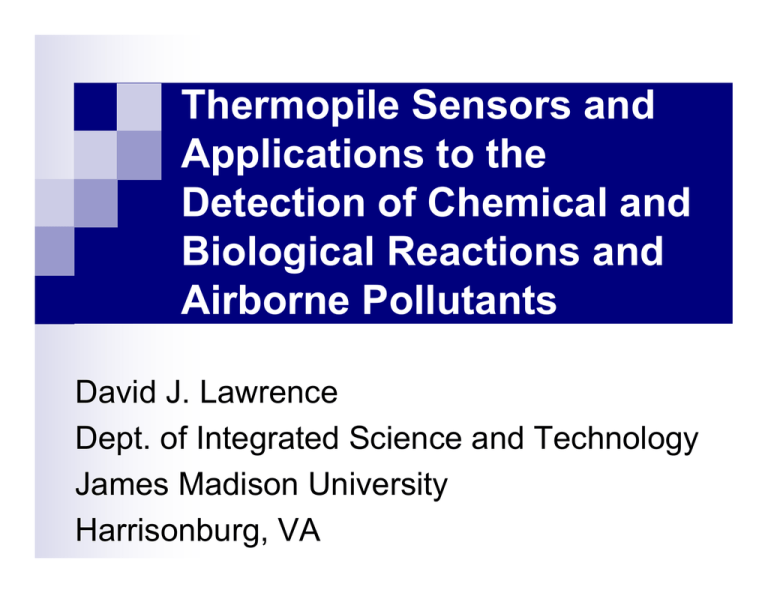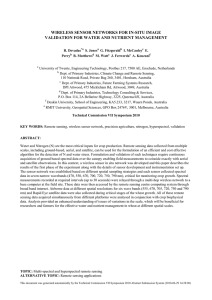Thermopile Sensors and Applications to the Detection of Chemical and Biological Reactions and
advertisement

Thermopile Sensors and Applications to the Detection of Chemical and Biological Reactions and Airborne Pollutants David J. Lawrence Dept. of Integrated Science and Technology James Madison University Harrisonburg, VA Team Members Faculty Members George L. Coffman*, W. Gene Tucker* and Thomas C. DeVore+ ISAT MS Students Noble Egekwu*, Greg Paulsen* BS Graduates Jason Bliss*, Austin Bennett*, Megan Riley*, Nick O’Grady*, Dan Aleman*, Patrick Olin*, Tiffany Jenkins*, John Gotwald*, David Berry+, and Maura Goodrich+ *Department of Integrated Science and Technology +Department of Chemistry Objective To design and microfabricate thermopile heat sensors that can be used in conjunction with chemical or biological coatings to detect the presence of chemical or biological agents in the air. The coating is applied over the heat sensing area of the thermopile. Heat is released when the chemical or biological agent to be detected binds to the coating. This heat is detected as an increase in the output voltage of the thermopile. Outline Thermocouples and thermopiles 36-junction thermopile design and microfabrication Thermopile characterization Sensing of ammonia and acid vapors Detection of biological reactions Cantilevered silicon thermocouples and thermopiles Thermocouples and Thermopiles The Seebeck Effect A temperature gradient along a conductor produces a potential difference. E.g., for a metal or n-type semiconductor: Voltage ΔV + − Temperature ΔT − The Seebeck Effect Voltage ΔV + − − Temperature ΔT The Seebeck coefficient is defined as the potential difference developed per unit temperature difference, i.e. ΔV S= ΔT ⎛V ⎞ ⎜ ⎟ ⎝K⎠ Seebeck Coefficient = S By convention, the sign of S is the potential of the cold side with respect to the hot side. Metal Bismuth (Bi) Nickel (Ni) Aluminum (Al) Copper (Cu) Gold (Au) Chromium (Cr) Antimony (Sb) S (μV/K) −79 −18.0 −1.7 +1.7 +1.8 +18.8 +43 Thermocouples A thermocouple consists of two junctions between two dissimilar conductors A and B. The Seebeck coefficient for the junction is equal to the difference in the coefficients of the two conductors, i.e. SAB = SA − SB For antimony (Sb) and (Bi): SSbBi = SSb − SBi = 43 +79 = 122 μV/K Sensing Junction Reference Junction Thermocouple Thermocouples & Thermopiles A thermocouple consists of two junctions between two dissimilar conductors. A thermoelectric voltage is generated whenever there is a temperature difference between the sensing junction and the reference junction. Thermopiles consist of multiple sensing/reference junctions in series, producing a greater output voltage than a single thermocouple. Sensing Junctions Reference Junctions Thermocouple Thermopile 36-Junction Thermopile Design and Microfabrication 36 - Junction Thermopile Bismuth - Antimony junctions 9 mm X 12 mm 60 µm line width Sensing junctions on polyimide or PET drumhead, reference junctions positioned over aluminum substrate. Chemical coating applied over sensing junctions. 36 - Junction Thermopiles These devices are microfabricated in arrays of three. They are attached to circuit boards using conductive epoxy. Wires are attached to the contact pads. Polyimide Film PET Film Thermopile Cross-Section Bismuth Aluminum Substrate Antimony Polyimide or PET Membrane “Drumhead” Membrane materials investigated: Kapton® polyimide Mylar® polyethylene terephthalate Melinex® polyethylene terephthalate Protective polystyrene layers are applied to some devices. Sensor Fabrication Aluminum substrates -- 1” x 1.5” 1.5” 1” Sensor Fabrication Polyimide or PET films are attached to the substrates. Film creates a “drumhead” over the holes to support the sensing junctions. Polyimide or PET Aluminum Substrate “Drumhead” Sensor Fabrication Substrates were treated with oxygen plasma to clean and roughen the surface. After cleaning, photoresist was applied to the substrates in a spin coater. Plasma Etcher Spin Coater Plasma Etcher Sensor Fabrication Photoresist layer was used to pattern subsequent metal coating. Photoresist Polyimide or PET Mask Aligner Mask Aligner Sensor Fabrication Samples were exposed to UV light in mask aligner through Mask #1. Developed and then rinsed with water. Developed Photoresist Mask #1 ( Bi ) 9 mm 9 mm Sensor Fabrication Bismuth was deposited on samples by thermal evaporation. Deposition Chamber Bismuth Metal Deposition Two Techniques: Evaporation Magnetron Sputtering Sensor Fabrication Lift-off was performed by soaking and sonication in acetone, leaving desired bismuth stripes on the film. Bismuth Sensor Fabrication Photolithography, deposition of antimony, and lift-off were performed with careful alignment of Mask #2 to the previous bismuth pattern to complete the thermopiles. Mask #1 ( Bi ) Mask #2 ( Sb ) 36 - Junction Thermopile Bismuth - Antimony junctions 9 mm X 12 mm 60 µm line width Sensing junctions on polyimide or PET drumhead, reference junctions positioned over aluminum substrate. 36 - Junction Thermopiles These devices are microfabricated in arrays of three. They are attached to circuit boards using conductive epoxy. Wires are attached to the contact pads. Polyimide Film PET Film Thermopile Characterization Sensor Uniformity Test 1.0E-03 9.0E-04 (V) A warm (37°C) aluminum plate is placed 7.2 cm above a three-sensor array. The responses of the three sensors to this radiant heat source are monitored. 8.0E-04 Output Voltage 6.0E-04 7.0E-04 5.0E-04 4.0E-04 3.0E-04 2.0E-04 1.0E-04 0.0E+00 0 5 10 Time 15 (s) 20 Thermopile Sensitivity Two techniques have been used to determine the thermopile sensitivity: Solvent (hexane) evaporation ∆Hvap = 31.56 kJ/mole Acid – base reaction Mg(OH)2 + HCl Hexane Evaporation Measured volumes of hexane are applied to the sensing junctions and the device output voltage is monitored as the solvent evaporates. Time 0 10 20 (s) 30 Sensor Output (V) 0.00 -0.01 -0.02 -0.03 -0.04 -0.05 0.5 μL 1.0 μL 40 Hexane Evaporation Integrated Sensor Output (V-s) 2.5 2.0 1.5 Polyimide 1.0 PET 0.5 Slope = 5.7 V-s/J 0.0 0.0 0.2 0.4 0.6 0.8 Energy to Vaporize Hexane (J) 1.0 Acid – Base Reaction An aqueous suspension of magnesium hydroxide nanoparticles was allowed to dry over the sensing junctions. ⇒ magnesium hydroxide coating 0.5 μL droplet of 0.0010 M HCl was applied to this coating. Mg(OH)2 + 2HCl ⇔ MgCl2 + 2H2O Calculated heat release = 2.9 x 10−5 J. Integrated thermopile output signal = 4.4 x 10−4 V-s. ⇒ sensitivity = 15 V-s/J Sensing of Ammonia and Acid Vapors Chemical Detection The ideal reactive coating for a thermal chemical sensor would: generate a large heat change for each pollutant molecule reacting with the coating, providing high sensitivity, react quickly, giving a rapid response time, and react only with the pollutant of interest, providing selectivity. Ammonia Detection Thermopiles coated with copper oxalate were used for the ammonia sensing experiments. CuC2O4 + 2NH3 ⇔ Cu(NH3)2C2O4 ΔHr = − 58 kJ/mole The copper oxalate was ground and the powder suspended in isopropyl alcohol. Drops of the suspension were placed over the sensing junctions and allowed to dry. ⇒ 0.1 to 0.2 mg copper oxalate coating A flow tube test apparatus was used to expose the sensor to air streams containing various concentrations of ammonia. Copper Oxalate Coated Thermopile The sensing junctions of this thermopile are coated with copper oxalate to enable ammonia detection. Copper Oxalate + NH3(g) N-H stretching oxalate bands Changes in the IR spectrum observed from adding NH3 to CuOX. Flow Tube Apparatus Air flow is perpendicular to the sensor array (200 mL/min). Ammonia vapor is drawn into a syringe from the headspace above aqueous ammonia solution (0.15 M). Ammonia is diluted in syringe with room air as desired. This vapor injected through a septum into the air stream at a location 28 cm upstream from the sensor (~ 1s injection). After injection the ammonia is further diluted by the air flow. Ammonia Sensing Typical responses to short term exposures to 0.060 and 1.4 ppm of ammonia from headspace above ammonia solution. 50 Sensor Output (μ V) 40 1.4 ppm 30 0.060 ppm 20 10 0 -10 -20 0 10 20 Time 30 (s) 40 Ammonia Sensing The integrated response of a copper oxalate coated sensor to a range of ammonia concentrations. Integrated Sensor Output (μV-s) 500 400 300 200 100 0 -2.0 15ppb – 180ppm ¾ Reaction Kinetics -1.0 0.0 1.0 Log [NH3 (ppm)] 2.0 3.0 Ammonia Sensing Challenges Chemical coatings can be sensitive but not selective. E.g., any amine will react with copper oxalate. We have found there to be significant heat exchanges associated with the adsorption of water vapor on copper oxalate coatings. We need to conduct further tests in a higher humidity environment. Acid Vapor Detection Thermopiles coated with magnesium hydroxide were used for acid vapor sensing experiments. When placed in the flow tube test apparatus, the devices responded to pulses of acid vapor from the headspace over aqueous nitric, sulfuric, and hydrochloric acids. For example, for HCl, Mg(OH)2 + 2HCl ⇔ MgCl2 + 2H2O HCl Sensing Typical responses to short term exposures to room air, humidified air, and 2000 ppm of HCl vapor from headspace above hydrochloric acid. (μ V) 250 Sensor Output 200 2000 ppm HCl 150 room air 100%RH air 100 50 0 -50 0 20 40 60 Time 80 (s) 100 120 Detection of Biological Reactions Detection of Biological Reactions Motivation: Is the detection of airborne anthrax spores possible? Began exploring this experimentally by working with a “model system” in aqueous solution. Biotin − Avidin Biotin − Avidin Interaction Biotin is a vitamin responsible for cell growth and the metabolism of fats and amino acids. Avidin is a protein made up of four identical subunits that have a high binding affinity for the vitamin Biotin. When Biotin binds to the Avidin protein, heat is given off: ΔHr = − 5.26 kJ/mole biotin Biotin − Avidin Testing Biotin and Avidin were each dissolved in separate Tris buffer solutions Biotin - 1.44 μg/μl Avidin - 100 μg/μl Sensing junctions were covered with a 1 μl droplet of the Avidin solution (1.5 x 10−9 mole). 1 μl droplet of Biotin solution was placed on the Avidin solution with a syringe (6 x 10−9 mole). Test Chamber for Experiments with Liquid Droplets Can be humidified to minimize evaporation. Biotin − Avidin Testing B: Biotin into Avidin A: Tris into Avidin B-A Detection of Biological Reactions: Next Steps Can we detect an antibody-antigen reaction? Bacillus collagen-like protein of anthracis (BclA) is a surface antigen on anthrax spores. We will place a droplet containing the antiBclA antibody on the sensing junctions of one of our devices. Can we detect heat released when BclA is added? Biological Sensing Challenges Biological (protein) sensor coatings can be more selective than chemical coatings, but they generate less heat. There can be difficulties binding the desired sensing protein to the sensor surface. Once bound, the sensing protein may become denatured. This may affect its recognition by an antibody. Cantilevered Silicon Thermocouples and Thermopiles Silicon as a Material for Thermocouples and Thermopiles Silicon has a large Seebeck coefficient. Sp ≥ 300 μV/K Sn ≤ −200 μV/K Silicon is quite strong, but brittle. Silicon can withstand high temperatures and many chemicals. Silicon has a high thermal conductivity. ~ 1000X that of polyimide or PET 10 − Junction Cantilevered Thermopile on Silicon Substrate N – type silicon substrate Nickel – p type silicon junctions Four complete devices are shown. Each is 5 mm X 10 mm Cantilevered sensing junctions (3 mm x 0.3mm x 25 μm thick) Sensor Fabrication Boron Diffusion Windows Contact Windows & Si Etch Windows Nickel Pattern Etching Through-Wafer Etching Completed devices: Cross-section: SiO2/BSG (insulator) N-type Si Nickel P-type Si Characterization: Hexane Evaporation A 0.5 μl droplet of hexane was applied to a single sensing junction and the device output voltage was monitored as the solvent evaporated. The droplet spread all along the cantilever, reaching the reference junction and resulting in substantial error. Amplified Output (V) Time (s) 10 12 0.00 -0.05 -0.10 -0.15 -0.20 -0.25 14 16 18 20 22 24 Characterization: Laser Heating He-Ne Laser (632.8 nm) Lens Sample Under Test (The thermocouple junctions are painted flat black.) TC Output (V) Characterization: Laser Heating 0.0030 0.0025 0.0020 τ ~ 76 ms 0.0015 0.0010 0.0005 0.0000 0 1 2 Time 3 4 5 (s) Laser power = 6.22 mW Sensitivity = 0.43 V/W (for a single junction) Concluding Remarks Bi-Sb thermopile sensors are easily fabricated and could be inexpensively mass produced. Copper oxalate coated devices can detect ammonia headspace vapor over an aqueous solution in the low or sub ppm range. Sensitivity to water vapor must be further investigated. New chemical coating materials must be developed. Aging of coatings must be investigated. Experiments on the detection of biological reactions are ongoing. Silicon-based thermopiles may offer advantages in some applications. This thermal sensing platform may complement detectors based on other sensing mechanisms. Acknowledgments Thanks to: Mark Starnes, JMU machinist. Joseph D. Rudmin for assistance with electronics. Funding by NIST under grant number 60NANB2D0108 (Critical Infrastructure Protection Program) through the Institute for Infrastructure and Information Assurance (IIIA) at JMU. The Materials Science REU Program funded by the US Department of Defense ASSURE Program, grant #DMR-0353773. Thank you! Hexane Evaporation (small droplets) Integrated Sensor Output (V-s) 2.5 2.0 1.5 1.0 Polyimide PET Polyimide PET 0.5 0.0 0.0 0.2 0.4 0.6 0.8 Energy to Vaporize Hexane (J) 1.0 Hexane Evaporation (effect of polystyrene coating) Integrated Sensor Output (V-s) 2.5 2.0 1.5 Polyimide 1.0 PET PI with PS coating 0.5 PET with PS coating 0.0 0.0 0.2 0.4 0.6 0.8 Energy to Vaporize Hexane (J) 1.0 Hexane Evaporation (comparison of large and small windows) Integrated Sensor Output (V-s) 2.5 2.0 1.5 Polyimide 1.0 PET 0.5 PI, Large Windows 0.0 0.0 0.2 0.4 0.6 0.8 Energy to Vaporize Hexane (J) 1.0 Ammonia Sensing For all but the two highest ammonia concentrations, the water vapor concentration delivered to the sensor was nearly constant. Water Vapor Concentration (ppm) Integrated Sensor Output (μV-s) 500 400 300 200 100 0 -2.0 -1.0 0.0 1.0 Log [NH3 (ppm)] 2.0 3.0 3000 2500 2000 1500 -2.0 -1.0 0.0 1.0 Log [NH3 (ppm)] 2.0 3.0






